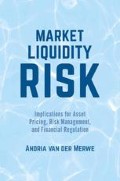Abstract
During noncrisis times, buyers and sellers usually show up in most markets to trade, and they can all go on to do what they usually do: invest, hedge, and speculate. During such noncrisis times, regulators monitor financial markets using established policy frameworks.
Access this chapter
Tax calculation will be finalised at checkout
Purchases are for personal use only
Preview
Unable to display preview. Download preview PDF.
Notes
John Maynard Keynes, 1936, General Theory of Employment, Interest and Money San Diego, New York and London: Harcourt.
M. K. Brunnermeier, 2009, “Deciphering the Liquidity and Credit Crunch 2007–2008”, Journal of Economic Perspectives, Vol. 23, pp. 77–100
G. Gorton, 2009, “Information Liquidity and the (Ongoing) Panic of 2007”, American Economic Review: Papers & Proceedings, Vol. 99, No. 2, pp. 567–572.
J. Coval, J. Jurek, and E. Stafford, 2009, “The Economics of Structured Finance”, Journal of Economic Perspectives Vol. 23, No. 1, pp. 3–25.
Marcia Stigum and Anthony Crescenzi, 2007, Stigum’s Money Market (4th ed.), New York: McGraw-Hill.
F. A. Longstaff, 2004, “The Flight-to-Liquidity Premium in U.S. Treasury Bond Prices”, Journal of Business, Vol. 77, No. 3, pp. 511–526.
O. Vasicek, 1977, “An Equilibrium Characterization of the Term Structure”, Journal of Financial Economics, Vol. 5, pp. 177–188.
Bengt Holmstrom and Jean Tirole, 2011, Inside or Outside Liquidity, Cambridge: MIT Press.
P. Pozsar, 2013, Institutional Cash Pools and the Triffin Dilemma of the U. S. Banking System. NYU Stern, Financial Markets, Institutions & Instruments: Topics in Financial Intermediation, New York: New York University Salomon Center and Wiley Periodicals.
Bengt Holmstrom and Jean Tirole, 2011, Inside or Outside Liquidity, Cambridge: MIT Press.
D. W Diamond and P. H. Dybvig, 1983, “Bank Runs, Deposit Insurance, and Liquidity”, Journal of Political Economy, Vol. 91, No. 3, pp. 401–419.
M. K. Brunnermeier, 2009, “Deciphering the Liquidity and Credit Crunch 2007–2008”, Journal of Economic Perspectives, Vol. 23, pp. 77–100.
D. Covitz, N. Liang, and G. A. Suarez, 2013, “The Evolution of a Financial Crisis: Collapse of the Asset-Backed Commercial Paper Market” The Journal of Finance, Vol. 68, No. 3, pp. 815–848.
G. Gorton and A. Metrick, 2012, “Securitized Banking and the Run on Repo”, Journal of Financial Economics Vol. 104, pp. 425–451.
D. W. Diamond and R. G. Rajan, 2011, “Fear of Fire Sales, Illiquidity Seeking and Credit Freezes”, Quarterly Journal of Economics, Vol. 126, Issue 2, pp. 557–591.
N. Gârleanu and L. H. Pedersen, 2011, “Margin-Based Asset Pricing and Deviations from the Law of One Price”, The Review of Financial Studies, Vol. 24, No. 6, pp. 1980–2022.
M. K. Brunnermeier and L. H. Pedersen, 2008, “Market Liquidity and Funding Liquidity”, The Society for Financial Studies, Vol. 22, no. 6, pp. 2202–2238.
R. C. Merton, 1987, “A Simple Model of Capital Market Equilibrium with Incomplete Information”, The Journal of Finance, Vol. 43, No. 3, pp. 483–510.
V V Acharya and L. H. Pedersen, 2005, “Asset Pricing with Liquidity Risk”, Journal of Financial Economics, Vol. 77, No. 2, pp. 373–410.
F. A. Longstaff, 2009, “Portfolio Claustrophobia: Asset Pricing in Markets with Illiquid Assets”, American Economic Review, Vol. 99, pp. 1119–1144.
L. Fisher, 1959, “Determinants of Risk Premiums on Corporate Bonds”, Journal of Political Economy, Vol. 67, No. 3, pp. 217–237.
Copyright information
© 2015 Andria van der Merwe
About this chapter
Cite this chapter
van der Merwe, A. (2015). Financial Crises and Liquidity Traffic Jams. In: Market Liquidity Risk. Palgrave Macmillan, New York. https://doi.org/10.1057/9781137389237_2
Download citation
DOI: https://doi.org/10.1057/9781137389237_2
Publisher Name: Palgrave Macmillan, New York
Print ISBN: 978-1-349-67863-1
Online ISBN: 978-1-137-38923-7
eBook Packages: Palgrave Economics & Finance CollectionEconomics and Finance (R0)

